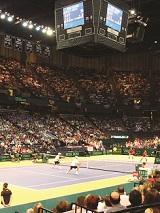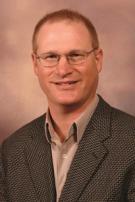

Good tennis center operators are always working to make their facilities as friendly as possible, for both tennis players and spectators. They pay close attention to what they call their facility’s ‘personality.’ Dimensions for courts remain the same from the recreational level up to the pro arenas, but that’s where the similarities end. Tennis can be played on a variety of surfaces, all of which will change the nature of the game.
A tennis facility’s ‘personality’ is also shaped by factors such as how helpful and friendly the staff is, by the maintenance of the courts and overall center itself, by the number of courts and how they’re laid out, by the amenities offered for both players and spectators/family members, and many other factors. Are there locker rooms? Are shaded seats and water available for players? Is there a snack bar or restaurant? Are there viewing areas and bleachers for spectators? Are the walkways wide and inviting?
Important for events coming into an area, a tennis facility’s personality also is affected by the local tennis scene. Is there regular activity going on on-court? Is there a ‘player culture,’ where tennis players like to hang out at the center? Is there an active local tennis association and community tennis infrastructure, which often helps to provide volunteers and support when events and tournaments are played at the center?

The USTA puts on tennis tournaments throughout the country, at every level—from juniors through recreational adult players of all ages, all the way up to the professional ranks. Not only are there national events, run by the national USTA office, but there are hundreds of regional, sectional, state and district events, which are run by each of the 17 USTA ‘sections’ around the country and other affiliated groups.
There also are a number of college events (including NCAA tourneys and the USTA Tennis on Campus program) and tournaments for recreational players run by non-USTA groups, such as the National Family Tennis Championships and World TeamTennis.
For tournament and event organizers looking to find that perfect tennis venue, the facility’s “personality” is definitely a consideration. Here are a number of locations with tennis facilities that might be exactly the right fit.
Alabama

That community passion for tennis also shows itself in Birmingham’s premier tennis facilities, including the 25-court Pelham Racquet Club, a public facility with 20 clay and five hard courts, all with lights. The beautifully landscaped facility is on three tiers, providing visibility for all courts. Another top venue in the area is the Highland Racquet Club, which has held many large junior events on its 10 clay and two hard courts. “Birmingham is a great sports town and our resume certainly speaks to that,” Galbaugh says.
Farther south, the Gulf Shores & Orange Beach Sports Commission makes things happen in partnership with those two cities, says Michelle Russ, the sports and events sales manager, and the area sees some large tennis tournaments every year, including statewide events. Public venues include the George C. Meyer Tennis Center, which has 18 courts (15 of them hard courts), with lights, spectator seating, covered pavilions and more, and the Orange Beach Tennis Center, with eight lighted hard courts and seating for fans.
Gulf Shores/Orange Beach also makes use of courts at two private facilities—the Peninsula Golf & Racquet Cub and The Beach Club, which each have eight clay courts. In addition, the area has the indoor red clay courts at the Gulf Coast Tennis Club. “What’s always attractive for a beach destination is the great weather throughout the year,” Russ says. “People come for a tournament and make it a mini-vacation.”
Of course, it’s hard to talk about tennis in Alabama without mentioning the Copeland-Cox Tennis Center (also known as the Mobile Tennis Center) in Mobile, one of the largest public tennis facilities in the world. Copeland-Cox hosts numerous tournaments that attract thousands of participants to its 60 hard courts.

In Overland Park, Justin Stine of the Overland Park Sports Alliance says the area “hasn’t yet targeted tennis much from a tournament standpoint, but we’re very interested in pursuing tennis tournaments and events.” And the area has the facilities to prove how serious they are.
The Overland Park Racquet Club is the largest tennis facility in the Kansas City area with 22 courts, including 14 climate-controlled indoor courts. The venue, which was voted one of the top 50 tennis clubs in the U.S. by Tennis magazine, also has the largest professional staff in the area, in addition to a full-service restaurant/bar, pro shop and other amenities, and has hosted a number of USTA events. Also, there is the Midtown Tennis Club in Overland Park, with nine indoor courts, and the Elite Squad Tennis Club, with six outdoor hard courts that are covered in winter.
North Carolina
North Carolina has a lot going for it, including tons of active and committed volunteers and staff that help make tennis events successful. One of the premier spots for tennis is the Cary Tennis Park, “a very unique and wonderful facility,” says Doug McRainey, director of parks, recreation and cultural resources for the Town of Cary. “We get a lot of compliments on the layout of our facility, with a central spine and banks of courts on either side, which lends itself to easy viewing, especially for families.”
Beautifully landscaped and maintained, Cary Tennis Park has 29 hard courts, including a stadium court, meeting room and pro shop. In 2006, it was named the “Outstanding Municipal Facility of the Year” by Racquet Sports Industry magazine. “The staff does an incredible job at managing big events and tournaments,” McRainey says.
The city of Greensboro is unique in the state for another reason—its clay courts. “We have 25 clay courts that the city manages,” says Wayne Simmons, the athletic supervisor for Greensboro Park & Rec. In the past year, the city hosted about 24 tournaments, he adds, everything from youth through adult tournaments, including a state championship this past June.
One of the top facilities in Greensboro is the J. Spencer Love Tennis Center, which has 13 lighted outdoor clay courts, locker rooms and bleachers and is home to the North Carolina Tennis Hall of Fame. The Latham Park Tennis Center has eight outdoor clay courts. And during the winter, there is the Simkins Indoor Sports Pavilion, with eight indoor courts. There are plenty of other facilities available, too, including eight hard courts at each of the city’s two high schools, 11 hard courts at Hester Park, and four hard and four clay courts at Memorial Stadium.

The Oklahoma City Tennis Center at Will Rogers Park hosts about 45 tournaments a year on its 24 lighted courts, from state high school championships to USTA regional events and more, says Holly Shelton, manager of sports business development for Visit OKC. Over the past five years, the city has invested more than $42 million to upgrade the facility, including a remodeled clubhouse. In addition, the Earlywine Tennis Center adds another 12 lighted courts to the mix.
“Both centers partner on a lot of events, so we can have 36 courts available between the two,” Shelton says. “The facilities do an amazing job; we’re excited to work with them.” For event organizers, Visit OKC helps throughout the process, including bids, she adds. “Once they get here, we make sure they know Oklahoma City is happy to have them.”
Tennessee
In Knoxville, the Tyson Park Family Tennis Center with 14 lighted courts, managed by the Park & Rec, is the home of “some really healthy tennis,” says Jennifer Morris, senior director of sales and services for the CVB. Tyson Park, next door to the University of Tennessee campus, sees a lot of regional tournament action. The city also works with the university’s tennis facility to host a number of collegiate events, too. Also available is the West Hills Tennis Center, which currently has 11 courts but is being built out with more courts and amenities.
“We work very directly with the Greater Knoxville Tennis Association,” Morris says. “We have a very healthy community of tennis people here, and they really know how to make events a success.”

The large facility in Abilene is the public Rose Park Tennis Center, which offers 15 lighted courts, changing rooms, covered bleachers and more. But the CVB also works in concert with other facilities when it comes to bringing tennis events to the area, says Debi Schultz, the sports sales director for the Abilene CVB.
Abilene Christian University, for instance, offers 10 courts in its Eager Tennis Pavilion and the Hardon-Simmons University Streich Tennis Center has eight lighted courts. In addition, the Abilene Country Club has eight courts and the Fairway Pavilion Racquet Sports Complex offers 12 courts.
Abilene plays host to a number of large USTA events, and also has been home to the AAA state team tennis championships for the last two years. “Besides helping to find great hotel deals and offering sports discounts, we try to make the teams and players feel welcome and special,” Schultz says.
In Amarillo, the “big kahuna,” says Eric Miller of the Convention and Visitors Council, is the Amarillo National Tennis Center, which is used for a lot of league play and has hosted a number of regional events. One key to successful events in the city, says Miller, is the Amarillo Area Tennis Association, which works with the CVC to help attract tournaments. “We really love it when we have some of our local residents involved,” he says. “That certainly helps to pull off a better event.”

